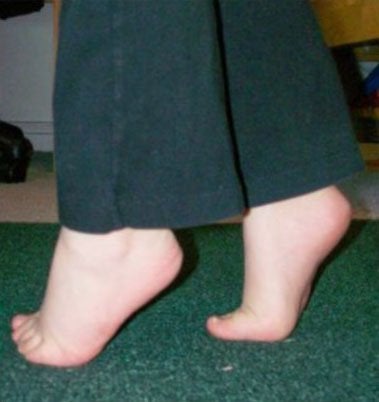-
Heel Pain
Heel pain is a stressful condition that effects day to day activities. Running and walking causes stress on the heel because the heel is the part of the foot that hits the ground first. This means that the heel is taking on your entire weight. Diagnosis and treatments for heel pain can be easily found through your podiatrist.
One of the main causes of heel pain is a condition known as plantar fasciitis. The plantar fascia is a band of tissue that extends along the bottom of the foot, from the toe to the bottom of the heel. A rip or tear in this ligament can cause inflammation of these tissues, resulting in heel pain. People who do not wear proper fitting shoes are often at risk of developing problems such as plantar fasciitis. Unnecessary stress from ill fitting shoes, weight change, excessive running, and wearing non-supportive shoes on hard surfaces are all causes of plantar fasciitis.
Achilles tendonitis is another cause of heel pain. Similar to plantar fasciitis, inflammation of the Achilles tendon will cause heel pain due to stress fractures and muscle tearing. A lack of flexibility of the ankle and heel is an indicator of Achilles tendonitis. If left untreated, this condition can lead to plantar fasciitis and cause even more pain on your heel.
A third cause of heel pain is a heel spur. A heel spur occurs when the tissues of the plantar fascia undergo a great deal of stress, leading to a separation of the ligament from the heel bone entirely. This results in a pointed fragment of bone on the ball of the foot, known as a heel spur.
Treatments for heel pain are easy and effective as long as problems are addressed quickly. The most common solution is simply taking stress off the feet, particularly off of the heel. This will ease the pain and allow the tendons and ligaments to relax. In the case of both plantar fasciitis and Achilles tendonitis, icing will reduce swelling of any part of the foot and anti-inflammatory medication is highly recommended. Properly fitting your shoes and wearing heel pads or comfort insoles will also reduce the risk of developing heel pain. Stretching before and after exercises such as running will help the foot muscles prepare for stress and lower the chances of inflammatory pain. In extreme cases, relieving heel pain might require surgery. Always make sure to discuss these symptoms and treatment options with your podiatrist to keep yourself active and pain free.
-
APMA Study Finds Americans Don’t Care About Their Feet
 The American Podiatric Medical Association recently published a study revealing that much of this nation’s foot pain goes untreated. In a survey of 1,000 people over the age of 18, 77% reported experiencing foot pain, but only a third of those claim they would see a podiatrist. Half of the participants with foot pain say that the pain has hindered walking, exercising, playing with grandchildren, and other daily activities.
The American Podiatric Medical Association recently published a study revealing that much of this nation’s foot pain goes untreated. In a survey of 1,000 people over the age of 18, 77% reported experiencing foot pain, but only a third of those claim they would see a podiatrist. Half of the participants with foot pain say that the pain has hindered walking, exercising, playing with grandchildren, and other daily activities. Among the group who sought podiatric help, 88% reported a quick diagnosis and 76% received treatment that eliminated the problem. A third of the group said that their visits to the podiatrist exposed other health concerns, such as diabetes, circulatory issues, and nerve issues.
“It’s not surprising to see how many people are affected by foot pain, when survey results show that we view our feet as the least important body part in terms of our overall health and wellbeing,” said AMPA President Frank Spinosa. “Our feet are literally and figuratively the furthest things from our minds.”
If you are experiencing pain in the feet or ankles, don’t join the stubborn majority refusing treatment. Seek the assistance of Jon M. Sherman, D.P.M. of Kentlands Foot & Ankle Center . Our doctor will provide the care you need to keep you pain free and on your feet.
What is a Podiatrist?
Someone would seek care of a podiatrist when they have suffered a foot injury or have common foot ailments such as: heal spurs, bunions, arch problems, deformities, ingrown toenails, corns, foot and ankle problems etc.
Podiatric Treatment
A podiatrist will treat the problematic areas of the feet, ankle or lower leg by prescribing the following:
- physical therapy
- drugs
- perform surgery on lower extremity fractures
- orthotic inserts or soles
A common podiatric procedure a podiatrist will use is a scanner or force plate which will allow the podiatrist to know the designs of orthotics. Patients are then told to follow a series of tasks to complete the treatment. The computer will scan the foot a see which areas show weight distribution and pressure points. The podiatrist will read the analysis and then determine which treatment plans are available.
If you have any questions, please feel free to contact our office located in Gaithersburg, MD . We offer the newest diagnostic and treatment technologies for all your foot and ankle needs.
Read more about What is a Podiatrist
-
What is a Podiatrist
The branch of medicine that is focused on the treatment, diagnosis, and study of disorders of the lower leg, ankle and foot is referred to as podiatry. Because people often spend a great deal of their time on their feet, many problems in this area can occur. A person seeks help from the field of podiatry when they need treatment for heel spurs, bunions, arch problems, deformities, ingrown toenails, corns, foot and ankle problems, infections, and problems with the foot that are related to diabetes and additional diseases.
To treat problems of the foot, ankle or lower leg, a podiatrist may prescribe physical therapy, drugs, perform surgery, or set fractures. Individuals may also be recommended to wear corrective shoe inserts, custom-made shoes, plaster casts and strappings in order to correct deformities.
When trying to gather information on a patient problem, a scanner or force plate may be used in order to design orthotics. During this procedure, patients are told to walk across a plate that is connected to a computer; the computer then takes a scan of the foot and indicates weight distribution and pressure points. The computer readouts will give the podiatrist information to help them determine the correct treatment plans.
Diagnosis is also provided through laboratory tests and x-rays. Through the foot, the first signs of serious problems such as heart disease, diabetes and arthritis can show up. For example, individuals that have diabetes may frequently have problems such as infections and foot ulcers because they experience poor circulation in the foot area. A podiatrist can then have consultations with patients when symptoms arise and referrals will be made to specialists that handle the greater health problems.
Some podiatrists have their own solo small private practices or clinics where they have a small staff and administrative personnel but many work within group practices. They usually spend time performing surgery in ambulatory surgical centers or hospitals or visiting patients in nursing homes. They typically spend between 30 to 60 hours of week working. Some podiatrists specialize in public health, orthopedics, surgery, or primary care. Some other fields include specialties in geriatrics, dermatology, pediatrics, diabetic foot care and sports medicine.
Some podiatrist specialists complete extra training in the area of foot and ankle reconstruction that result from the effects of physical trauma or diabetes. There are also surgeons that perform surgery of a cosmetic nature to correct bunions and hammertoes.
-
Forget Barefoot; New Trendsetter in Running Shoes Is Cushioning
Athletes who spent the past few years embracing or scorning barefoot running can now consider whether increasingly popular “maximalist” shoes — with their chunky, heavily cushioned soles — are the sport’s new wonder product… Read More Here. http://mobile.nytimes.com/2015/02/17/sports/forget-barefoot-many-seek-cushioning-in-running-shoes.html?smprod=nytcore-iphone&smid=nytcore-iphone-share&_r=1&referrer= -
Oktoberfest 2014
We hope to see all of you this Sunday October 12 at the annual City of Gaithersburg Oktoberfest. There will be games, rides and activities for every member in your family. Authentic German food and music will be available all day long.
Kentlands Foot & Ankle Center will have a booth from 12-5pm alone Briscoe Street. We will be handing out free goodies (while supplies last) and Dr. Sherman will be available to answer all of your podiatric health questions.
Still unsure about Oktoberfest? Conde Nast travel magazine rated it one of the best in the country! Check out the article here.
For more information regarding Oktoberfest please visit the City of Gaithersburg website.
-
NFL Injury Week
This past week of football was a tough week for some star players. Washington’s own RGIII suffered another setback with a dislocated ankle, and the Benglas’ A.J. Green is out with possible turf toe.
Dislocated ankles are a tough injury for athelete’s and can mean weeks of recovery and physical therapy to get back into competetive shape. Here at Kentlands Foot & Ankle Center we like to see someone immediately after the injury to prevent secondary injury and stabilize the joint. Typically we would place a patient in a walking boot to keep the ankle stable while it heals. Physical therapy to stregnthen the muscles around the joint would follow after a few weeks.
For more information on ankle sprains, dislocation or breaks please call our office at 301-330-5666.
Check out the article for more information on players’ injuries.
SB Nation reports on NFL Week 2.
-
Kentlands Foot and Ankle
Welcome to our blog! Come back soon for more updates!
RECENT POSTS
categories
- Uncategorized
- Featured Articles
- Foot Disorders
- Broken Ankle
- Broken Toe
- Fracture
- Foot Health
- Foot Care
- Arthritis
- Foot Pain
- Skin Cancer
- Podiatry Appointment
- Custom Orthotics
- Podiatrist
- Diabetes
- Gout
- Heart Health
- National Nutrition Month
- National Foot Health Awareness Month
- Foot Safety
- Foot and Ankle Injuries
- Falls Prevention
- Chronic Heel Pain
- Shoes
- Laser Therapy
- Quoted
- Physical Therapy
- KeryFlex
- Sweat
- Summer Foot Care
- Sports Injury
- ESWT
- Fungal Toenails
- Bunion



